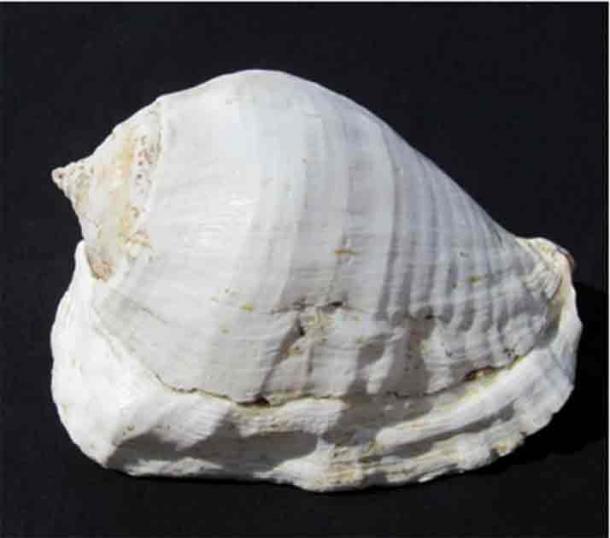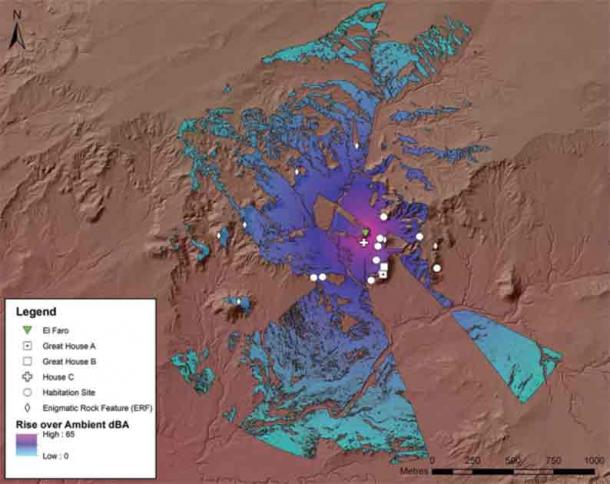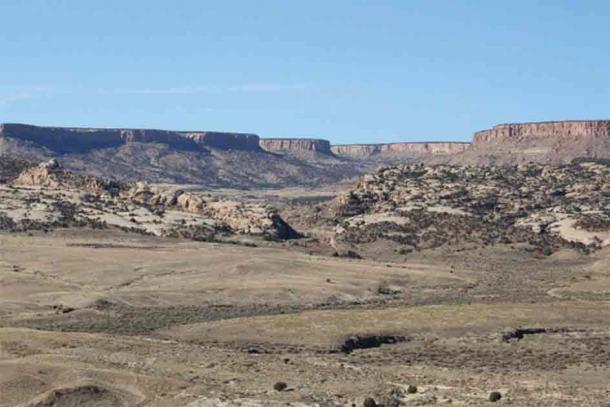
Ancient Chacoan Settlements Used Conch-Shell Trumpets to Keep in Touch
A team of archaeologists from universities in New York and Arizona have just published a fascinating new study that reports on the impressive auditory range of conch-shell trumpets used by Native Americans who occupied the lands of modern-day New Mexico more than 1,000 years ago.
In an article appearing in the journal Antiquity, the archaeologists present evidence showing that pre-Columbian Pueblo peoples living in the American Southwest in the 9th through 12th centuries relied on these homemade wind instruments to communicate and preserve community connections across relatively long distances. Even if people living in different settlements were out of site, they were seldom out of sound range, thanks to the prodigious acoustical characteristics of these timeless “musical instruments.”
- Ancient Acoustic Artifacts and Communication with the Gods
- Ancient Deer Antler Instruments Discovered in Vietnam After 3,000 Years
Before Cell Phones and Wi-Fi, There Were Conch-Shell Trumpets
The ancient indigenous residents of northwest New Mexico built a thriving culture that settled in significant numbers in the Chaco Canyon, a 53-square-mile (147.5-sq km) gorge located on the rocky and semi-arid Colorado Plateau. These Native Americans lived in small communities inside the canyon, and in the areas surrounding it as well, each of which was organized around a grand central building known as a great house, which featured several hundred rooms spread out over multiple floors. These great houses were likely used for a mixture of public purposes, related to the administrative, religious, economic and cultural practices of the Chacoan people.
- 23,000-Year-Old Human Footprints Found In New Mexico Are Revolutionary
- The Mysterious Extra Fingers and Toes of the Pueblo People of Chaco Canyon

Strombus galeatus conch shell from the Sea of Cortez. (Richard Loose/Antiquity Publications Ltd)
Many conch-shell trumpets have been recovered from excavations in Chaco Canyon, which is currently recognized as both a National Historical Park and a World Heritage site. Conch shells are the rescued outer remains of many varieties of large sea snails, which would have been harvested for food from the waters of the Caribbean and the Atlantic Ocean by people living in coastal areas.
Conch shells were traded widely across Mesoamerican territory in ancient times, as they were used for ceremonial purposes and communication by many different cultures. In fact, trumpets or horns made from the discarded shells of sea snails have been found at archaeological sites all around the world, revealing their universal usefulness based on their capacity to produce surprisingly loud sounds.
Previous research has shown that these early wind instruments were used in various ceremonies of a spiritual nature in pre-Columbian Mesoamerica. But they may have had practical uses as well, and that is what the team of investigators involved in the new research project were trying to confirm.
“Chaco Canyon is surrounded by over one hundred understudied great house communities,” the new study’s lead author, Professor Ruth Van Dyke from Binghamton University, explained. “We sought to determine if extra-canyon great house communities demonstrated relationships similar to Chaco Canyon between landscape, community layout, and sound.”
What this means is that the researchers wanted to find out how and how far the sounds made by conch-shell trumpets would echo across the landscape, when they were “played” by trumpeters standing just outside one of the great houses.
To make these determinations, the archaeologists did not travel to the site to blow the trumpets and record the sounds from different locations, as might have been necessary in the past. Instead, they relied on an innovative virtual program known as Soundshed Analysis that can uncover such information using digitally generated models or re-creations of conditions on the ground.

Modelled audible reach of a conch-shell blast from Pierre’s El Faro (Ruth M. Van Dyke et al./Antiquity Publications Ltd).
In this study, the researchers used Soundshed Analysis software to calculate the distribution and characteristics of sound waves that would be created by conch-shell trumpets blown at full-force from the vicinity of five great houses from five Chacoan communities just outside Chaco Canyon. Intriguingly, they found that such sounds would be audible to those living in almost all surrounding settlements, indicating that a person in one great house could communicate with a person in another great house without difficulty.
Dismissing the idea that this could be coincidence, the archaeologists concluded that the Chacoan people must have used these trumpets for inter-community communication. The sound of the trumpet could have been used to announce all types of events, activities, or developments of interest, based on variations in the number and/or duration of the “notes” played on the instrument. There may have been a conch-shell trumpet “language,” in other words, that Chacoan people would know and understand.
“Our study of soundscapes in Chacoan great-house communities allows a tantalizing glimpse into community cohesion,” the study authors wrote in their Antiquity article. “Our research suggests that, like the reach of the sound of a church bell in medieval times, the sound of a conch-shell trumpet may have been one element binding Chacoan communities together.” They pointed out that “a conch-shell blast would have been a more effective method than relying on community residents to look in the right direction at the right time to see, for example, smoke/mirror signals.”
The archaeologists aren’t certain if the practice of building communities within trumpet range was based on prescription or choice. If it were the former Chacoan laws may have prohibited Pueblo peoples from constructing communities outside acoustic range, and if it were the latter new communities might have decided on their own to build within that range to make sure they remained informed and engaged.
Navigating the Challenges of Acoustical Preservation at Ancient Chacoan Sites
The Chacoan people lived in northern New Mexico in the semi-arid San Juan Basin on the Colorado Plateau from approximately 850 to 1250 BC. Their central gathering place was in Chaco Canyon, which at the height of its occupation boasted a population of about 5,000 people living in approximately 75 small settlements. The settlements they built outside the canyon followed the same blueprints, and the construction of these communities was presumably made necessary by space limitations that led to the ancient equivalent of modern urban sprawl.
Chacoan settlements ultimately spread out to cover an area of the Colorado Plateau that surpassed the size of modern-day England. But Chaco Canyon was a sacred site and the true ancestral home of the region’s Pueblo peoples, and thus it was a place that everyone visited frequently and knew well.
The canyon was filled with 15 major building complexes constructed from sandstone blocks and timber that had been transported across long distances. It functioned as a residential, economic, administrative and ceremonial/spiritual center all at the same time. People from throughout the region came to the canyon to visit its thriving marketplace, in which foods, goods made from turquoise and other valuable items (like conch-shell trumpets) were exchanged freely, and to participate in religious rituals or observances of various types.
While the individual settlements in Chaco Canyon were relatively small in population, they were interconnected through a vast and expansive network of roads, ramps, bridges and other throughways that made it easy to arrive at public gathering spots from anywhere in the area. The infrastructure in Chaco Canyon was similar to what would be found in a small city today, although overall population density was low by modern standards.

An overview of the Morris 40 community, facing west-northwest. The great house sits at the base of the sandstone ridge to the left of the arroyo (Throgmorton/Antiquity Publications Ltd.)
The same type of infrastructure could be found in Chacoan settlements located elsewhere on the Colorado Plateau, indicating the cultural unity that the Pueblo people were determined to preserve even as their population expanded. Given the character of their society, it is hardly surprising to discover that they also relied on sound to create communications networks that crisscrossed the landscape.
“Soundscapes were meaningful dimensions of past experiences, landscapes, and environments and are important facets of social interaction in the ancient world,” Professor Van Dyke stated, summarizing the findings of his team’s research project.
Based on the implications of their discoveries, he believes that “management of archaeological and heritage sites should incorporate consideration of the auditory environment” in the future. This could expand the scope of preservation and restoration activities at large-scale archaeological sites like those linked to the Chacoan culture, since protecting the acoustical characteristics of such sites will be necessary to preserve their true historical integrity.
Top image: Left; Kin Klizhin is an ‘ancestral’ community consisting of a great house with tower kiva. Right; Strombus galeatus conch shell from the Sea of Cortez. Source: Van Dyke/Antiquity Publications Ltd
By Nathan Falde















